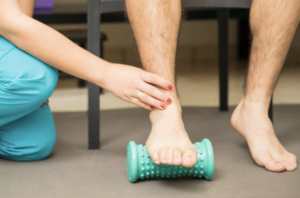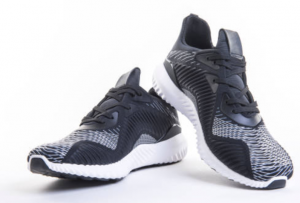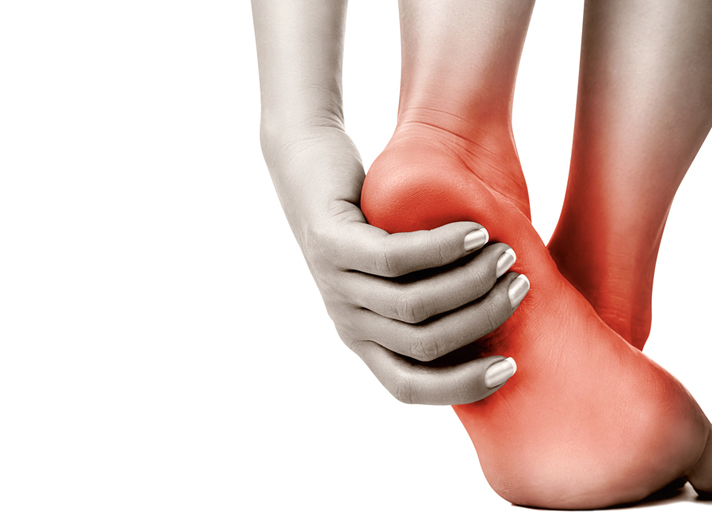Is that shooting pain a sports injury… or could it be plantar fasciitis?
If you’ve ever experienced the heel hell of the piercing pain at the bottom of your foot, you know it can seriously cramp your style.
Under normal circumstances, the plantar fascia — which runs across the bottom of your foot and connects your heel bone to your toes — acts like a shock-absorbing bowstring, supporting the arch in your foot.
If tension on that bowstring becomes too great, it can create small tears in the fascia which can lead to pain and swelling, called ‘plantar fasciitis’.
Risk Factors of Plantar Fasciitis
Plantar fasciitis commonly causes stabbing pain that usually occurs with your very first steps in the morning. Once your foot limbers up, the pain of plantar fasciitis normally decreases, but it may return after long periods of standing, after getting up from a seated position, or when climbing stairs.

Plantar fasciitis is particularly common in runners, but can also affect others, particularly those with the following risk factors:
- Age: Plantar fasciitis is most common between the ages of 40 and 60.
- Certain types of exercise: Activities that place a lot of stress on your heel and attached tissue — such as long-distance running, ballet dancing and dance aerobics — can contribute to an earlier onset of plantar fasciitis.
- Faulty foot mechanics: Being flat-footed, having a high arch, excessive pronation (having your feet roll inward too much when you walk) or other such characteristics can adversely affect the way weight is distributed when you’re standing and put added stress on the plantar fascia.
- Obesity: If you are overweight, excess pounds can put extra stress on your plantar fascia.
- Occupation: Factory workers, teachers, soldiers and others who spend most of their work hours walking or standing on hard surfaces can damage their plantar fascia.
- Footwear: You are more prone to develop plantar fasciitis if you wear shoes that don’t fit well, are worn out, or otherwise uncomfortable — especially high heels (ladies, take note!)
Treatment for Plantar Fasciitis
If severe heel pain appears out of nowhere, seek treatment from a podiatrist immediately. X-rays or other tests may be required before a diagnosis is made.

If you are quite athletic, it is possible that the plantar fascia could actually be ruptured, which may require a short cast and/or crutches to recover.
No single treatment works best for everyone with plantar fasciitis. However, there are many things you can try to help your foot get better, include cutting back on strenuous activities and investing in a pair of podiatrist-approved footwear that better supports your feet.
Stretching and strengthening exercises or use of specialised devices may provide symptom relief. These include:
- Physical therapy: A physical therapist can instruct you in a series of exercises to stretch the plantar fascia and Achilles tendon and to strengthen lower leg muscles, which stabilise your ankle and heel. A therapist may also teach you to apply athletic taping to support the bottom of your foot.
 Night splints: Your physical therapist or doctor may recommend wearing a splint that stretches your calf and the arch of your foot while you sleep. This holds the plantar fascia and Achilles tendon in a lengthened position overnight and facilitates stretching.
Night splints: Your physical therapist or doctor may recommend wearing a splint that stretches your calf and the arch of your foot while you sleep. This holds the plantar fascia and Achilles tendon in a lengthened position overnight and facilitates stretching.
- Orthotics: Your doctor may prescribe off-the-shelf heel cups, cushions or custom-fitted arch supports to help distribute pressure to your feet more evenly.
If these treatments do not help, your doctor might recommend:
- Steroid shots: Injecting a type of steroid medication into the tender area can provide temporary pain relief. Multiple injections aren’t recommended because they can weaken your plantar fascia and possibly cause it to rupture, as well as shrink the fat pad covering your heel bone.
- Extracorporeal shock wave therapy: In this procedure, sound waves are directed at the area of heel pain to stimulate healing. It’s usually used for chronic plantar fasciitis that hasn’t responded to more-conservative treatments. This procedure may cause bruises, swelling, pain, numbness or tingling and has not been shown to be consistently effective.
- Surgery: Few people need surgery to detach the plantar fascia from the heel bone. It’s generally an option only when the pain is severe and all else fails. Side effects include a weakening of the arch in your foot.
Preventative Self-care Tips

To reduce the pain of plantar fasciitis, or avoid it happening at all, try these self-care tips:
- Maintain a healthy weight: This minimises the stress on your plantar fascia.
- Choose supportive shoes: Avoid high heels. Buy shoes with a low to moderate heel, good arch support and shock absorbency. Don’t go barefoot, especially on hard surfaces.
- Don’t wear worn-out athletic shoes: Replace your old athletic shoes before they stop supporting and cushioning your feet. If you’re a runner, buy new shoes after about 500 miles of use.
- Change your sport: Try a low-impact sport, such as swimming or bicycling, instead of walking or jogging.
- Apply ice: Hold a cloth-covered ice pack over the area of pain for 15 to 20 minutes three or four times a day or after activity. Or try ice massage. Freeze a water-filled paper cup and roll it over the site of discomfort for about five to seven minutes. Regular ice massage can help reduce pain and inflammation.
- Stretch your arches: Simple home exercises can stretch your plantar fascia, Achilles tendon and calf muscles.
Ignoring plantar fasciitis may result in chronic heel pain that hinders your regular activities. If you change the way you walk to minimise plantar fasciitis pain, you might also develop foot, knee, hip or back problems.
If you do think your heel pain may be plantar fasciitis, visit your doctor as soon as possible. Your feet (not to mention the rest of your body) will thank you!

